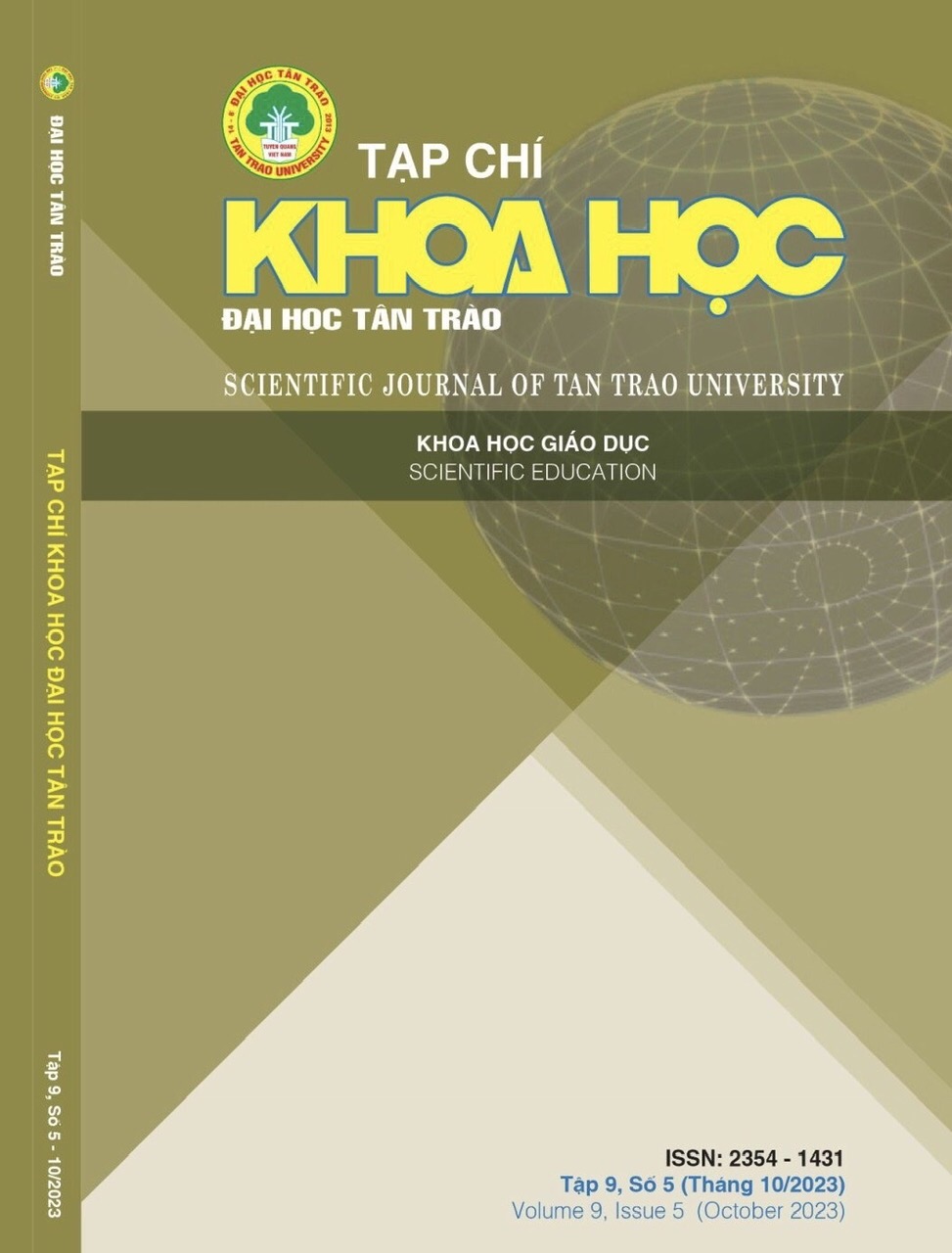TÍCH HỢP GIÁO DỤC THÍCH ỨNG BIẾN ĐỔI KHÍ HẬU VÀ PHÒNG CHỐNG THIÊN TAI TRONG MÔN ĐỊA LÝ LỚP 12 CHO HỌC SINH THPT
DOI:
https://doi.org/10.51453/2354-1431/2023/896Tóm tắt
Trong giai đoạn mới hiện nay, việc định hướng đổi mới căn bản, toàn diện giáo dục phổ thông đã đưa ra quan điểm: "Dạy học tích hợp, với mục tiêu phát triển các năng lực ở người học, giúp họ có khả năng giải quyết các vấn đề thực tiễn và đáp ứng sự biến đổi nhanh chóng của xã hội hiện đại để đem lại thành công cao nhất trong cuộc sống". Quan điểm này đã bắt đầu được thực hiện trong dạy học ở tất cả các cấp học, môn học ở nhà trường phổ thông.
Ở các môn học ở trường phổ thông thông qua nhiều bậc học, cấp học, môn học như Hóa học, Sinh học, Công nghệ, Vật lí và đặc biệt là Địa lí. Môn Địa lí là một môn học có nhiều khả năng và cơ hội thuận lợi để dạy học tích hợp và mang lại nhiều kết quả khả quan bởi đặc trưng môn học gắn liền với thực tế thiên nhiên, nó phản ánh một cách sát thực vấn đề nóng bỏng hiện nay. Vì kiến thức môn học rộng bao gồm môi trường tự nhiên, môi trường kinh tế xã hội và các mối quan hệ cơ bản của nó. Muốn hiểu rõ, hiểu sâu các kiến thức địa lí rất cần đến kiến thức của nhiều môn học khác, từ đó có thể vận dụng kiến thức địa lí vào giải quyết các vấn đề thực tiễn. Nội dung của bài báo này chúng tôi đề cập đến việc tích hợp giáo dục thích ứng biến đổi khí hậu (BĐKH) và phòng chống thiên tai (PCTT) trong môn Địa lí lớp 12 cho học sinh THPT, nhằm tạo hứng thú học tập, phát triển năng lực vận dụng kiến thức địa lí để giải thích được các hiện tượng tự nhiên và vấn đề xã hội đang quan tâm, đặc biệt vấn đề biến đổi khí hậu và rủi ro thiên tai đã và đang tác động mạnh mẽ tiêu cực và trực tiếp đến hệ thống tự nhiên, hoạt động kinh tế và môi trường của người dân Việt Nam.
Tải xuống
Tài liệu tham khảo
[1] Ministry of Education and Training (2018), General Education Program, Issued under Circular No. 32/2018/TT-BGDĐT dated December 26, 2018 of the Minister of Education and Training.
[2] Ministry of Education and Training (2006), General Education Program - Geography, Hanoi.
[3] Ministry of Education and Training (2019), Educational materials on disaster prevention and response to climate change in preschools, high schools, Vietnam Education Publishing.
[4] Thong, L. (Editor-in-Chief), et al (2017) Geography 12 Textbook, Vietnam Education Publishing, Hanoi.
[5] Thong, L., Tue, N.M. (co-editor) and publisher (2018), Teaching and developing the capacity of Geography in high school, Pedagogical University Publishing, Hanoi.
[6] Tra, D.H. (editor) et al (2015), Mathematical teaching to develop students’ ability, Book 1: Natural Science, Book 2: Social Science. Publisher of Pedagogical University, Hanoi.
7] Tra, D.H. (2013), Teaching integrated to develop student capacity, Book 2 - Social Science, Hanoi National University of Education Publishing House.
[8] Thoa, D.T.K. (2014). Experiential activities creativity - perspective from the theory “Learning from experience. Proceedings of the workshop on experiential activities creativity of high school students.
[9] Duc, N.T. et al. (2012), Education to respond to climate change in Geography at lower secondary level, Textbook for teachers and administrators.
[10] Nhung, N.T.H. (2020), Integrating disaster prevention education and climate change response in 9th grade geography teaching at junior high schools towards capacity development, Education Journal No. 489 (Term 1 - 11/2020, pages 43-47).
[11] Van, N.T.T. (2013), Determining the content and methods of educating disaster prevention skills through Vietnamese geography in high schools. Thesis of Master of Education. Hue University of Pedagogy.
[12] Thi, T.T.M. (2015), Climate change education and teaching concepts that integrate climate change content in Vietnamese high school. Journal of Science and Education, University of Education - University of Danang, No. 15, pages 97-101.
Tải xuống
Đã Xuất bản
Cách trích dẫn
Số
Chuyên mục
Giấy phép

Tác phẩm này được cấp phép theo Giấy phép Quốc tế Creative Commons Attribution-ShareAlike 4.0 .
Bài báo được xuất bản ở Tạp chí Khoa học Đại học Tân Trào được cấp phép theo giấy phép Ghi công - Chia sẻ tương tự 4.0 Quốc tế (CC BY-SA). Theo đó, các tác giả khác có thể sao chép, chuyển đổi hay phân phối lại các bài báo này với mục đích hợp pháp trên mọi phương tiện, với điều kiện họ trích dẫn tác giả, Tạp chí Khoa học Đại học Tân Trào và đường link đến bản quyền; nêu rõ các thay đổi đã thực hiện và các nghiên cứu đăng lại được tiến hành theo cùng một bản quyền.
Bản quyền bài báo thuộc về các tác giả, không hạn chế số lượng. Tạp chí Khoa học Tân Trào được cấp giấy phép không độc quyền để xuất bản bài báo với tư cách nhà xuất bản nguồn, kèm theo quyền thương mại để in các bài báo cung cấp cho các thư viện và cá nhân.
Mặc dù các điều khoản của giấy phép CC BY-SA không dành cho các tác giả (với tư cách là người giữ bản quyền của bài báo, họ không bị hạn chế về quyền hạn), khi gửi bài tới Tạp chí Khoa học Đại học Tân Trào, tác giả cần đáp ứng quyền của độc giả, và cần cấp quyền cho bên thứ 3 sử dụng bài báo của họ trong phạm vi của giấy phép.






